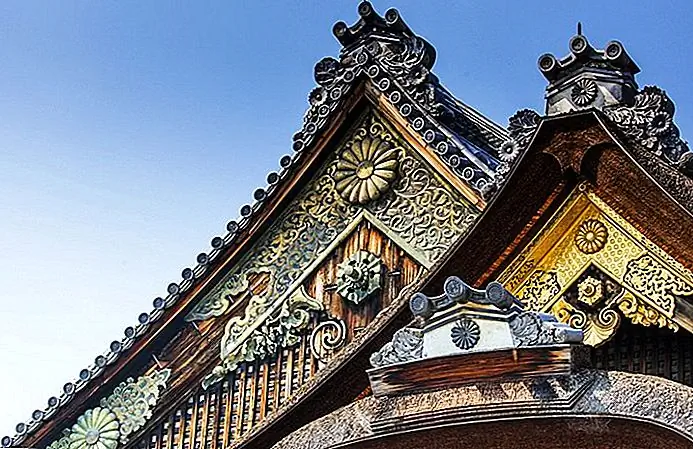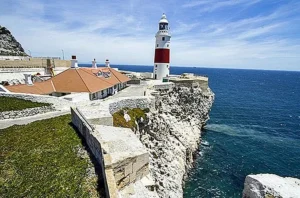Surrounded by the hills of central Honshu, Kyoto is one of Japan’s largest cities and the educational center of Western Japan with several universities and higher education institutions. Although it is one of the top tourist destinations in Japan, it has managed to retain much of the atmosphere of the past, as it was the only major Japanese city to escape the destruction of World War II. Famous as the emperor’s residence and Japan’s most important cultural center for nearly 1,100 years, Kyoto today has countless fine examples of sculptures, paintings and other art forms in its many museums and galleries. The city is also home to ancient architecture, largely influenced by Buddhism and found in well-preserved temples.
Read also: Top-Rated Tourist Attractions in Japan
1 Nijo Castle
Nijo Castle, complete with walls, towers and a moat, was built in 1603 and later served as the seat of government. The complex has several buildings housing many important works of art and is famous as the location the Emperor chose to issue the rescript to abolish the once powerful Shogunate. Highlights include the castle’s eastern gate (Higashi Otemon, the main entrance); the inner gate or Karamon, notable for its beautiful carvings and decorated metalwork; and further, the extended Mikuruma-yose. The main building of the site is Ninomaru Palaceconsisting of five separate buildings connected by corridors, and with beautiful interiors decorated with paintings by Kano Tanyu and his students. The main apartment is the Hall of the Imperial Envoy (Jodan-no-ma), brought together in splendor by the adjoining rooms, Ni-no-ma and Tozamurai-no-ma with their paintings of tigers. Also interesting is the adjacent building with its large Audience Hall surrounded by a gallery and with sliding doors with large paintings of larch trees on a gold background. The fourth building, the Kuro-Shoin, has animal paintings by Kano Naonobu, while in the Shogun’s private apartments there are paintings of mountain landscapes.
Adres: 541 Nijojocho, Nakagyo Ward, Kyoto, Kyoto Prefecture 604-8301
2 Fushimi-Inari Taisha Shrine

One of Japan’s most famous shrines, the Fushimi-Inari Shrine is a must-visit in Kyoto. Founded in 711 AD and dedicated to the goddess of rice cultivation, Ukanomitama-no-mikoto, the shrine is still visited by traders and traders who pray for prosperity. The main building dates from 1499 and has a spectacular four-kilometre-long avenue of bright orange “torii” or arches, each dedicated by a company (it takes about two hours to drive around the 32,000 arches along the route). Also notable are the many sculptures of foxes, known as messengers of the gods. Hot Tip: Strengthen yourself with the purchase of traditional Japanese fortune cookies from the shops and stands at the entrance of the shrine.
3 Kinkaku-ji: The Golden Pavilion

Originally built in the 14th century as a rest house for Shogun Ashikaga Yoshimitsu and now a Zen Buddhist temple, the beautiful Golden Pavilion (Kinkaku-ji) is one of Kyoto’s most picturesque attractions. Taking its name from the gold leaf that adorns the top two of its three floors – a design element believed to alleviate the negativity associated with death – the structure has been rebuilt to its original form a number of times, this most recent incarnation dating back to the late 1950s. Built over a large pond, the site is also known for its beautiful grounds, as well as the ancient stone pagoda and the Sekkatei teahouse with traditionally prepared drinks.
Adres: 1 Kinkakujicho, Kita Ward, Kyoto, Kyoto Prefecture 603-836
4 Kiyomizu-dera-tempel

In the eastern part of Kyoto, Kiyomizu Temple, a major UNESCO World Heritage Site, enjoys a scenic location on Mount Otowa overlooking the city. Visitors can enjoy a lovely walk to the temple along scenic Tea-pot Lanewith its small shops and craft shops. Founded in 790 AD and dedicated to the 11-headed Kannon, the Buddhist Goddess of Mercy, whose statue can be seen here, the existing buildings were built after 1633 during the period of the third Tokugawa Shogun, Iemitsu, and stood mainly on a rocky outcrop high above Otowa Waterfall. Highlights include the grand terrace of the Great Hall, built on 30-meter-high pillars with five rows of crossbeams and used as a stage for temple dances and ceremonies. The terrace offers spectacular views over the city and surrounding forested hills, especially when the leaves change color in autumn.
Adres: 294 Kiyomizu 1-chome, Higashiyama Ward, Kyoto, Kyoto Prefecture 605-0862
Official site: www.kiyomizudera.or.jp/lang/01.html
5 Sanjūsangen-dō Temple

Sanjūsangen-dō (Rengyoin Temple), or the Temple of the 33 Niches, takes its name from its rather unusual structure, with its facade divided into 33 (sanjusan) niches (gen) to represent the belief that Kannon, the Goddess or Mercy, could take on 33 different personifications. Originally built in 1164, the current elongated building was built in 1266 after a fire destroyed its predecessor, with evidence of its former importance as a place of training in archery still seen in the many holes in its ancient pillars and beams made by arrowheads. The most important of his many works of art is the Kannon with a Thousand Hands, an almost three-and-a-half-meter-high statue, which dates from the 13th century and is notable for the 500 standing figures of Kannon arranged on either side of it.
Adres: 657 Higashiyama Ward, Kyoto, Kyoto Prefecture 605-0941
6 Kyoto Imperial Palace

The original Kyoto Imperial Palace (Kyoto-gosho ), built in AD 794 and replaced several times after being destroyed by fire, remains one of the city’s most visited historical sites. Although the current building was built in 1855, it still makes an impression. The palace is located in a large (once walled) space near the heart of the city and includes highlights such as the beautifully decorated gates and the chance to see some of the palace’s most important rooms and buildings, including the Hall or State Ceremonies. (Shishinden), the Imperial Residence (Seiryo-den), the Courtroom (Ko-gosho) and the Imperial Library. Although the beautiful grounds of this Kyoto landmark are open to the public,
Adres: 3 Kyoto-Gyoen, Kamigyo Ward, Kyoto, Kyoto Prefecture 602-0881
7 Nishi Honganji-tempel

The main temple of the original Jodo-shinshu sect, Nishi Honganji Temple, is an excellent example of Buddhist architecture. Highlights include the Hondo or Great Hall, rebuilt in 1760 with a number of beautiful rooms decorated with gold-background paintings and numerous important statues, some dating from the 6th century. Also of interest is the Founder’s Hall (Daishi-do) with its acclaimed statue of Shinran, carved in 1244 and later covered with a layer of lacquer mixed with his ashes. Another notable building is the Daishoin, or treasury, with several rooms named after the beautiful wall and ceiling paintings that decorate them, including the Sparrow Room (Suzume-no-ma), the Room of the Wild Geese (Gan-no-ma) and the Chrysanthemum Room (Kiku-no-ma) with its fine 17th century paintings of flowers in gold and white by Kaiho Yusetsu. Also of interest is the Higashi-Honganji Temple of the Jodo-shinshu sect, founded in 1602 and home to a number of examples of fine works of art. Hot Tip: Only a few parts of these temples are open to the public, so be sure to make your arrangements in advance for other areas that are not normally accessible.
8 The Kyoto National Museum and the City Museum of Art

In addition to the many beautiful ancient temples with their important works of art, Kyoto also boasts some impressive collections in its many world-class museums and galleries. Perhaps best known is the National Museum, an art gallery founded in 1897 and widely considered the most important museum in Japan. The museum focuses mainly on pre-modern Asian art, particularly examples from Japan, and was completely renovated in 2014. It offers numerous examples of historical and applied art spread across a number of buildings (be prepared for a lot of walking). Also worth seeing is Kyoto Municipal Museum of Art, opened in 1928 and featuring important works by Takeuchi Seihō, one of the leading Japanese artists of the 20th century.
Address: 527 Chayacho, Kyoto, Kyoto Prefecture 605-0931
Official site: www.kyohaku.go.jp/eng/index.html
9 Gion’s Geishas and Temples

Famous as a nightlife and geisha district, Gion is an area of Kyoto that is great for exploring on foot. Gion, on the eastern bank of the Kamogawa River, is an eclectic mix of modern architecture and historic beauty that offers a unique flavor to numerous Japanese traditions, from the elaborately dressed geishas to well-preserved 17th-century restaurants and teahouses that offer a taste of the old offer Japan. Centered around an area that includes Hanami-Koji Street, Shijo-Dori Street and the waterfront promenade of Shirakawa Minami-Dori Street, Gion is also famous for its many fine temples, most notably the 15th century Silver Pavilion ( Ginkakuji ) and the Chion-in Temple, one of Japan’s most famous temples, notable for its 24-meter-high two-story tower (Sammon-san), which houses the country’s largest bell weighing 71 tons, cast in 1633, and only available during festivals in mid-April .
Address: Nishi Ten-o-cho, Okazaki, Sakyo-ku, Kyoto, Kansai 606-8341
10 Katsura Imperial Villa

Katsura Imperial Villa
Originally built in 1624 for Prince Hachijo Toshihito, brother of Emperor Goyozei, the Katsura Imperial Villa is home to one of Japan’s most famous historic gardens. Designed by Kobori Enshu with the help of the prince, this beautiful garden is laid out in such a way that the visitor always sees things from the front; smaller gardens are grouped around a large swimming pool with the peaks of Mounts Arashiyama and Kameyama in the background. Highlights include the Miyuki-mon Gates and the many garden paths, some made of river pebbles and others of rectangular cobblestones, lined with mosses and shrubs, and leading through further gates into the courtyard garden with a group of buildings known as the Goths at its center. A special highlight here is Furu-shoin’s veranda, specially designed to allow observation of the moon,
Adres: Katsuramisono, Kyoto, Kyoto Prefecture 615-8014
11 Daitoku-ji-tempel

The Daitoku-ji Temple – the Zen Temple of the Great Virtue – is one of the most important temples of the Rinzai sect and was founded in 1324, with the current structures dating from the 16th and 17th centuries. Of the 22 buildings on the site, seven are open to the public, including the Kara-mon, a Chinese-style gate with beautiful carvings, and the two-story main gate, Sammon, built in 1589 and notable for its many fine ceiling paintings and images. The Great Hall, the Butsuden (or Daiyu-den), was built in 1664 and contains a statue of Shakyamuni with his disciples Anna and Kayo and a figure of Daito-kokushi, the temple’s first abbot. Beyond the Great Hall is the Lecture Hall, or Hatto, based on Chinese models, and the Hojo, or Abbot’s Lodging, with its paintings, wooden tablet and adjacent garden.
Adres: 3 Murasakino Daitokujicho, Kyoto, Kyoto Prefecture 603-8231
12 The Byōdō-in Temple

Founded in 988, Byōdō-in Temple has many unique buildings, shrines and works of art worth visiting. Highlights include the Phoenix Hall (Hoo-do), with its bronze phoenixes on the two facades and rich interior; 11th-century paintings, including an imposing gilded figure of Amida; and an altar and ceiling inlaid with bronze and mother-of-pearl. Adjacent is the Kannon-do, a hall directly above the river and known as the Tsuridono or fishing room. Be sure to spend time visiting the temple gardens with their many beautiful ponds, as well as the Byōdō-in Museum with its treasures relating to the temple grounds, including its 52 wooden Buddha statues, carved phoenixes and the original temple bell. Also worth visiting is the Zen Tenryu-ji Temple, from where you can access the beautiful Arashiyama Bamboo Grove , an area full of tall bamboo that is simply breathtaking.
Adres: Renge-116 Uji, Kyoto Prefecture 611-0021
Official site: www.byodoin.or.jp/ja/en.html
Where to Stay in Kyoto for Sightseeing
The best place to stay in Kyoto is downtown, preferably in or near the Gion or Kawaramachi-Dori districts. These areas are central to many of the main attractions, as well as dining, shopping and entertainment. Below are some highly rated hotels near these areas:
- Luxury Hotels: Located on the banks of the Kamogawa River, the Ritz Carlton offers unparalleled luxury and service, four restaurants and a well-regarded spa. A short walk from the main station, Hotel Kanra Kyoto has large, modern rooms with beautiful cedar bathtubs. Located in the heart of Gion district, Maifukan offers well-appointed rooms with mini refrigerators. This hotel also has a rooftop terrace.
- Mid-range hotels: Close to the central station is the Ohanabo. This is a small, cozy hotel in a quiet area, with comfortable rooms and a popular restaurant. The contemporary Hotel Anteroom is perfect for those looking for something different. This hotel features an art gallery and unique rooms that are tastefully compact but highly functional, including some with terraces. The Citadines Karasuma-Gojo is a good option for longer stays, with large rooms with a kitchen and seating area.
- Budget Hotels: The ibis Styles Kyoto Station hotel has an excellent central location and offers efficient rooms and free breakfast. Located in the heart of Kawaramachi-Dori shopping area, Super Hotel also serves complimentary breakfast, with modern and cozy rooms. For a more traditional Japanese experience, Ryokan Shimizu features rooms with futons and tatami mats and an on-site onsen (hot spring).
Tips and tours: how to make the most of your visit to Kyoto
- See the view: If you want to see all of Kyoto’s highlights in one day, the Full-Day Kyoto Tour Including Nijo Castle and Kiyomizu Temple is an excellent option. An experienced guide provides fascinating historical context to the attractions on this full-day tour, including visits to Kinkaku-ji Temple, Nijo Castle, and the Kyoto Imperial Palace. End your tour with breathtaking views of Kyoto from the terrace of Kiyomizu Temple. Note that this tour involves a lot of walking around the attractions. Pickup from selected hotels, lunch, and entrance fees are all included.
Read also:
top-notch day trips from Kyoto





